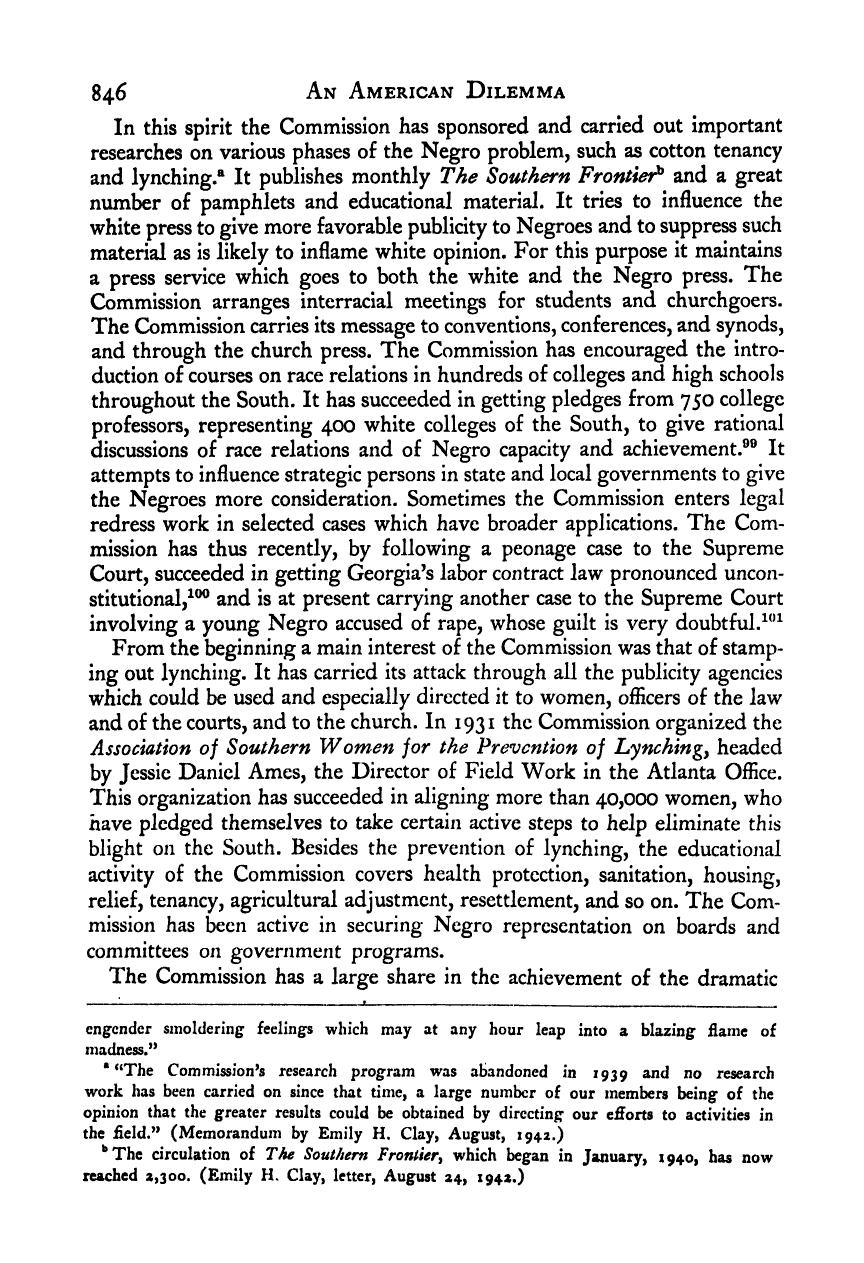Note: Gunnar Myrdal died in 1987, less than 70 years ago. Therefore, this work is protected by copyright, restricting your legal rights to reproduce it. However, you are welcome to view it on screen, as you do now. Read more about copyright.
Full resolution (TIFF) - On this page / på denna sida - IX. Leadership and Concerted Action - 39. Negro Improvement and Protest Organizations - 11. The Commission on Interracial Cooperation

<< prev. page << föreg. sida << >> nästa sida >> next page >>
Below is the raw OCR text
from the above scanned image.
Do you see an error? Proofread the page now!
Här nedan syns maskintolkade texten från faksimilbilden ovan.
Ser du något fel? Korrekturläs sidan nu!
This page has never been proofread. / Denna sida har aldrig korrekturlästs.
846 An American Dilemma
In this spirit the Commission has sponsored and carried out important
researches on various phases of the Negro problem, such as cotton tenancy
and lynching.® It publishes monthly The Southern Frontier^ and a great
number of pamphlets and educational material. It tries to influence the
white press to give more favorable publicity to Negroes and to suppress such
material as is likely to inflame white opinion. For this purpose it maintains
a press service which goes to both the white and the Negro press. The
Commission arranges interracial meetings for students and churchgoers.
The Commission carries its message to conventions, conferences, and synods,
and through the church press. The Commission has encouraged the intro-
duction of courses on race relations in hundreds of colleges and high schools
throughout the South. It has succeeded in getting pledges from 750 college
professors, representing 400 white colleges of the South, to give rational
discussions of race relations and of Negro capacity and achievement.®® It
attempts to influence strategic persons in state and local governments to give
the Negroes more consideration. Sometimes the Commission enters legal
redress work in selected cases which have broader applications. The Com-
mission has thus recently, by following a peonage case to the Supreme
Court, succeeded in getting Georgia’s labor contract law pronounced uncon-
stitutional,^®® and is at present carrying another case to the Supreme Court
involving a young Negro accused of rape, whose guilt is very doubtful.
From the beginning a main interest of the Commission was that of stamp-
ing out lynching. It has carried its attack through all the publicity agencies
which could be used and especially directed it to women, ofiicers of the law
and of the courts, and to the church. In 1931 the Commission organized the
Association of Southern Women for the Prevention of Lynching^ headed
by Jessie Daniel Ames, the Director of Field Work in the Atlanta Office.
This organization has succeeded in aligning more than 40,000 women, who
have pledged themselves to take certain active steps to help eliminate this
blight on the South. Besides the prevention of lynching, the educational
activity of the Commission covers health protection, sanitation, housing,
relief, tenancy, agricultural adjustment, resettlement, and so on. The Com-
mission has been active in securing Negro representation on boards and
committees on government programs.
The Commission has a large share in the achievement of the dramatic
engender smoldering feelings which may at any hour leap into a blazing flame of
madness.”
<< prev. page << föreg. sida << >> nästa sida >> next page >>